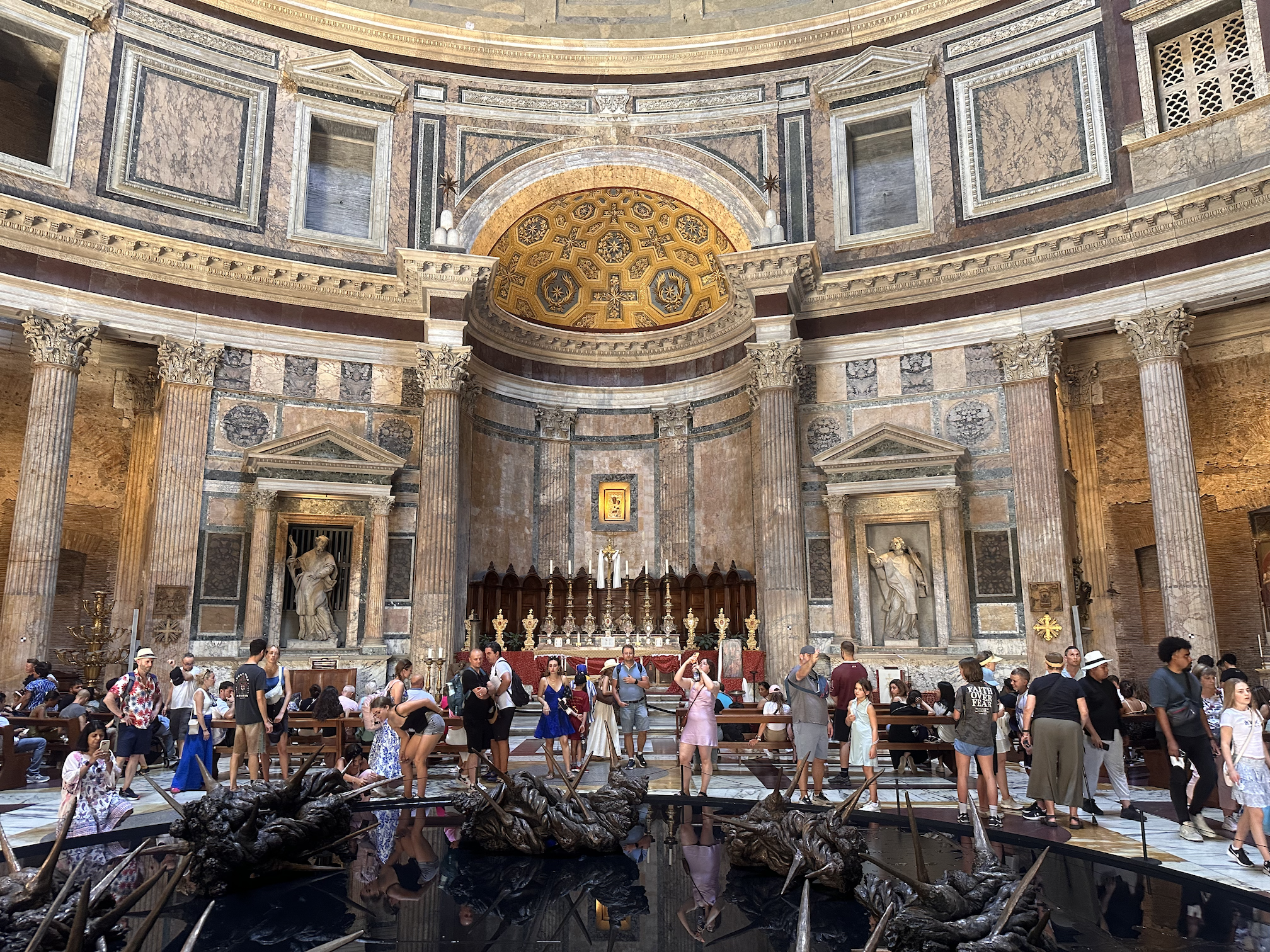Experiencing the Pantheon in Rome
Alex and I had the extraordinary opportunity to attend Saturday mass inside the Pantheon in Rome, Italy. Standing in a place so steeped in history was nothing short of awe-inspiring. We actually arrived as visitors, not knowing that mass was happening, and left with another reminder of how powerful human ambition can be.
Originally constructed by Marcus Agrippa around 27 BC, the Pantheon was designed as a place of worship and sacrifice for all the Roman gods—which is where the name comes from: Pan meaning “all” and Theon meaning “gods.” Later, the temple was destroyed by fire, leaving just the front façade. Between 118 and 128 AD, Emperor Hadrian rebuilt the temple, preserving Agrippa’s inscription on the front. In 609 AD, the Pantheon was consecrated as a Christian church, becoming Santa Maria ad Martyres—a designation it still holds today. Now, surrounding the interior walls of the Basilica are images, sculptures, and homages to Saint Mary and the many martyrs who died for their Christian faith.
Walking through the literal doors of a building first erected in 27 BC—27 years before the birth of Christ—was a deeply moving experience. The fact that this structure has stood for nearly 2,000 years is a testament to human ambition and craftsmanship. And though we did sit for the surprise (to us) mass, I found that the constant movement of tourists made it difficult to focus on the service.
Speaking of tourists: Prior to visiting the Pantheon, I was tempted to purchase a ticket online via Viator, which I use often for tour tickets. However, I’m glad I didn’t. Entry tickets to the Pantheon Basilica are just $5 at the door, which is substantially cheaper than those offered online. While a ticket is required at the door, a tour guide is not. You can easily read the descriptions of the sculptures that line the walls—there’s really no need for a guide here.
The space itself is breathtaking. From the grand oculus above that floods the rotunda with light, to the intricate marble floors and vibrant artwork, every inch of the Pantheon radiates beauty and splendor. One of the most striking features was the statue of the Crown of Thorns that greeted us as we entered—an evocative symbol of faith, sacrifice, and the Catholic Church. A tour may not be necessary; sitting still and simply taking it all in will do you far more justice than listening to someone speak—this is what I ended up doing.
Despite the distractions of ongoing tours, experiencing mass in a place where ancient Roman gods were once worshipped—and where faith has endured through centuries—was unforgettable. The Pantheon remains a powerful reminder of history, art, and the enduring human spirit.
Essential Pantheon Travel Tips
Buy Tickets at the Door
Entry tickets to the Pantheon Basilica are just $5 (EUR) at the entrance. Avoid overpaying on third-party websites unless you specifically want a guided tour.
Mass Schedule
Daily mass times can vary, but on Saturdays, mass is usually held at 5 p.m. On Sunday, mass begins at 12 p.m. Be prepared for ongoing services during your visit, and remember to be respectful if you choose to stay.Best Time to Visit
Arrive early in the morning or later in the evening to avoid the heaviest tourist crowds. Midday tends to be the busiest, especially in peak travel seasons.Dress Modestly
As the Pantheon is an active church, dress codes similar to other Roman Catholic sites apply—shoulders and knees should be covered out of respect.Photography
Photos are allowed, but flash is discouraged, especially during mass. Be mindful of other visitors and worshippers when taking pictures.No Guide Needed
Detailed plaques and signs provide plenty of information about the Pantheon’s history and art—making a guide unnecessary for most visitors.Take Time to Sit
Don’t rush through. Take a seat, look up at the oculus, and let the space inspire you. This can be one of the most powerful parts of the visit.
Frequently Asked Questions
-
Most visitors spend 30 minutes to an hour exploring. Consider sitting quietly inside to truly absorb the atmosphere.
-
Not necessarily. The Pantheon’s interior is easy to explore on your own, and detailed plaques explain its artwork and architecture.
-
No advance booking is needed if you plan to buy your ticket at the entrance. Online tickets cost more due to booking fees but may include skip-the-line privileges.
Please note that your wait at the ticket line may be extended during times of heavy tourism.












